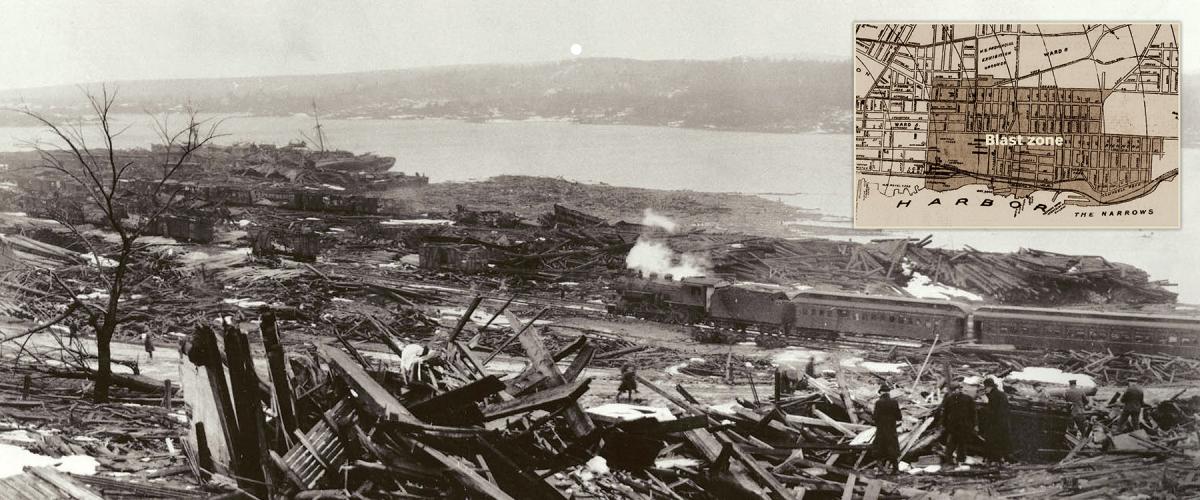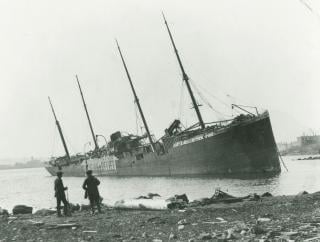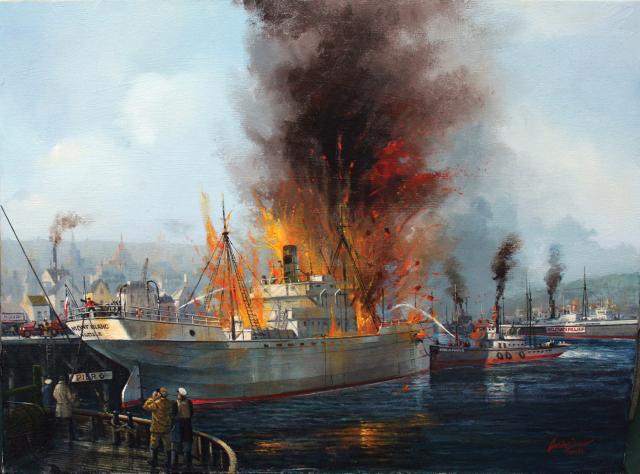It was just after 0845 on Thursday, 6 December 1917, when a ship was seen burning in the Narrows, a narrowing portion of the entrance to Nova Scotia’s Halifax Harbor. Crowds began to assemble on the banks of the harbor, including hundreds who mounted a new bridge across the rail yards with a perfect view of the burning ship. It was an entertaining sight—sudden bursts of flame would penetrate the huge black smoke column, almost like a fireworks display.
More and more gawkers arranged themselves on the bridge and on the harbor banks of Halifax and the neighboring city of Dartmouth across the harbor.
And none of them—schoolchildren, housewives, factory workers, soldiers, or seamen—knew they were only a few short minutes from the event that would alter or end their lives. As they watched the drifting ship, few were aware they soon would witness a catastrophe that would be the greatest man-made explosion in world history—a record that would be broken only by the atomic blast in Hiroshima 28 years later.
Gradually the word spread that two ships had collided in the Narrows, setting one on fire. It was discovered later that the burning ship was the French-chartered Mont-Blanc, which had collided with the outward-bound Imo, but the principal ingredient for disaster—the Mont-Blanc’s cargo—was known to few. The Mont-Blanc had been waiting to enter the harbor until submarine nets guarding the entrance were opened. Only a few harbor personnel knew she carried a cargo of explosives headed for the Western Front. Usually, ammunition ships flew a red flag indicating the hazardous cargo, but for various reasons the Mont-Blanc did not and showed no outward sign of the peril stored within her holds.
Halifax in December 1917 had a population of about 60,000, up considerably from 47,000 in the prewar days. It was the main port for the formation of transatlantic convoys, so military and civilians there flocked to provide the many services needed to handle the war goods being brought in by ship. Land forces, too, assembled there to meet the troopships that would take them to Europe, and many Haligonians had been lost fighting the Germans.
The city and the port could trace their history from the first settlement in 1749 to 1865, a period of growth and even prosperity. As the second largest natural harbor in the world—second only to Sydney, Australia—Halifax was a mecca for goods and services needed worldwide. American/Canadian relations, however, often were stressed by the Canadian belief that the new United States wanted part of Canada and made no secret of its interest.
After 1865, with some political unrest and with many exporters sending their goods via the intercolonial railway, Haligonians for many years suffered a decline in national importance. Halifax experienced a rebound in the late 1800s and early 1900s when tourism sprouted and new ocean liners began stopping at the port. The ocean liners provided some relief, but that relief was cloaked in tragedy. On 1 April 1873, the White Star liner Atlantic left Liverpool for New York, but, running short of coal, Captain James Williams decided to try for Halifax. The Atlantic struck a reef off Nova Scotia at full speed and sank in a few minutes. All the women and children on board died except one young boy. Out of 952 passengers and crew, 562 perished.
Yet, the biggest and best-known loss was the Titanic on 15 April 1912. Halifax felt that loss immediately, since most of the recovered dead and survivors were brought to the city for identification and treatment. That event took the lives of 1,503, some of the world’s richest and most famous individuals. It was up to Halifax to bury the dead and comfort the survivors. Haligonians did not know at the time that a much larger effort would be required in a little more than five years.
The two ships involved in the 1917 collision—the Imo and Mont-Blanc—were both old but still very serviceable transports, typical of many World War I vessels. The Mont-Blanc’s captain, Aimé Joseph Le Medec, was seasoned but not experienced in ships as large as his current vessel. In New York, he was given two deck-mounted guns, a new and unfamiliar reminder of possible conflict.
The ship was owned by Compagnie Générale Transatlantique (CGT), but it was her cargo that frightened the master and his crew: six million pounds of explosives of various makes, including 62 tons of gun cotton, 250 tons of TNT, and 2,366 tons of picric acid. These were destined for the Allies’ Western Front. Because this cargo was volatile, all precautions were taken on board to prevent sparks or sudden jars, but there was a last-minute addition of barrels of benzol—a highly flammable liquid capable of setting off the explosives stored below should it ignite. The barrels of benzol stored on deck would make a perfect fuse should they ever catch fire. On the night of 5 December, the Mont-Blanc impatiently waited to enter Halifax Harbor in the early morning hours after a nervous coastal trip from New York with her touchy cargo.
The second ship, the Imo, was larger but empty, having come from Belgium to pick up humanitarian goods for that war-torn nation. She was chartered by the Belgium Relief Commission and was bound for New York to pick up the supplies. On her side she proclaimed her neutrality with a huge white sign with the words “Belgian Relief” in great red letters. Captain Haaken From, at 47, was experienced and considered competent.
the ship were vaporized in the explosion. The Halifax Disaster/Austin Dwyer
The Imo awaited her eastbound entry into the Narrows on her way to the ocean, while the Mont-Blanc anxiously began her westward entry. With From on board the Imo was Halifax pilot William Hayes, who had just arrived after a good night’s sleep in his home, as the Imo had missed leaving on 5 December when the sub gates closed.
Pilot Francis Mackey had spent the night of the 5th on board the Mont-Blanc. At 0750 the anchor was raised and the ship started slowly toward Halifax Harbor and the inner Bedford Basin. Rules of the road in the Narrows required ships entering from the east to hug the Dartmouth shore on the right, while those departing were to stay to their right near the Halifax banks. For some reason, Captain From had the Imo more to the center on this day. Communication between ships was normally done by ship’s whistles, and as the Imo and the Mont-Blanc sighted each other, they began a series of confusing blasts yet continued to head straight for each other. Even as the their whistles blew and captains shouted, at 0846 the two ships collided.
By this time both ships had reversed engines, and their speeds were minimal. Still, the Imo cut deeply into several holds of the Mont-Blanc. Both ships stopped, and the Imo began to pull out of the Mont-Blanc’s gash. In so doing, sparks flew as metal ground on metal, and the flammable benzol ignited. The fuse was now lit.
As the fire on board the Mont-Blanc grew, the crew of the ship knew the danger should the flames reach the TNT and gunpowder below and decided to abandon ship. So the entire crew, including Captain Le Medec and pilot Francis Mackey, jumped into their two lifeboats and, pulling as if their lives depended on it, rowed toward the Dartmouth shore. During their flight they shouted at nearby tugs and vessels that the ship would explode, but their shouting was in French and ignored. The crew knew the danger, so after beaching their boats on the Dartmouth shore, they frantically raced up the hills to the woods near the top, leaving the harbor onlookers to their fate.
The ammunition ship was now adrift with no crew and heading toward the Halifax dock area. The fire grew and reached barrels of benzol, blowing them high into the morning sky. Other ships in the area, knowing nothing of the danger, headed for the burning ship, hoping to stop the fire from spreading. The crowd kept growing, drawn to the huge plume of black smoke rising ever upward.
Railroad yard dispatcher Vincent Coleman and yard manager William Lovett were debating leaving their railroad office when a sailor broke in shouting that there was going to be an explosion. The two ran out the door, but Coleman turned back to send out a message to incoming train No. 10, warning it to stay away. Coleman’s telegraph message may have indicated his fear: “Munitions ship on fire in the Harbour. Making for Pier 6. Goodbye.”
Fourteen-year-old Barbara Orr, on her way to school, stood watching the scene, but not overly concerned, she continued to walk to school. Suddenly, everything became deadly quiet, and she thought to herself, “Something awful is going to happen!”
And at 0904 on 6 December 1917, the explosion occurred, instantly turning the Mont-Blanc into a giant grenade, sending shrapnel in every direction. Following the incident, the only recognizable parts of the ship were the anchor shank, which weighed 1,000 pounds, found four miles away, and one of the deck guns, which was found three miles away. The force of the blast was so great it literally vaporized small boats and those trying to put out the Mont-Blanc fire.
Barbara Orr was thrown through the air almost a third of a mile, fortunately landing on the uphill slope of Fort Needham. She suffered foot and ankle injuries and was covered in oily soot, which covered almost everything and everybody, but she survived. Sadly, her father, mother, three brothers, two sisters, and uncle were killed in the explosion.
The scene that confronted survivors was so incredible it was difficult to absorb. Buildings, homes, churches, and schools had become wreckage, and death was everywhere. Those who had been on the bridge watching the fire were vaporized, and most bodies were never discovered. Pier 6 was no more. Factories were just rubble, and electric poles and wires snared passersby and snarled rescuers, who had almost immediately appeared and begun their grisly work. The widespread burning rubble made it seem like Hell.
Yet the danger was far from over. The immense force of the explosion forced water into great tidal waves that swept the shores of both Halifax and Dartmouth, pushing everything outward and dragging helpless victims back to drown. The air was filled with an oily grease that seemed to penetrate everything and coated survivors with a substance that made many unrecognizable.
Shock waves were so powerful that buildings were turned into rubble in an instant and shattered window glass flew directly into the eyes of onlookers, blinding many. Those on shore were killed or suffered life-shattering wounds; those on board the ships in the harbor fared little better. Six of the Imo’s crew were killed, including the pilot Hayes and Captain From. Although the harbor was crowded with some 40 vessels, the only U.S. ship on record as being present was the cargo ship Curaca, there to load horses and wheat for Europe. She was docked at Pier 8, and the explosion hurled, washed, or carried her across to Tufts Bay, where she sank. Various casualty reports indicate that 45 of the crew perished in the event, but three managed to survive. The ship eventually was refloated in 1918.
Railroad yard dispatcher Coleman died, too, but his last frantic message saved the incoming trains from adding to the disaster. His message was the first news of the tragedy and began an outpouring of relief efforts that continued for months. Boston, in particular, sent a relief train almost immediately and more aid to follow later. To this day, the people of Nova Scotia honor Boston by sending the city a Christmas tree each year.
Those first few days were spent searching for the dead and patching up the injured. Numbers of children, including Barbara Orr, were orphans and had to be placed with new families. Despite the still-burning fires and the easily dislodged ruins of buildings, servicemen and survivors dug, often bare-handed, into the grisly carnage. They found a few survivors, but mostly uncovered remains, either whole bodies or just body parts. The stories and recollections of those days are so compelling and so pitiful that they are hard to digest.
Nature seemed to want to blot out the sight of this tragedy, and on 7 and 8 December, blizzards dumped snow over much of the area so that from afar, the horror was hidden from view. Yet that same snow and cold slowed rescue efforts, and more survivors died in the ruins.
The full accounting of loss from the explosion was never complete, but the official tally listed 1,953 people killed and an estimated 9,000 injured. The blast destroyed 6,000 buildings and left 25,000 homeless. However, the death toll undoubtedly was considerably higher, possibly as high as 3,000. There never was a complete list of the missing and supposed dead. The number of eye injuries was significant, with as many as 362 suffering some optic injury, with 41 totally blinded.
Individual stories only made the heartache more personal. Author Sally M. Walker closes her book, Blizzard of Glass, with these words that may seem appropriate today:
The Halifax Harbour explosion is a tale of devastation and despair. It is equally a tale of recovery and hope. With the telling of each small story. People alive today connect with the people on that fateful December day. We feel their joy, their sorrow, and finally the hope that sustained them in the days that followed. Their stories become a part of us. We become a part of them. And so life continues.
Sources
John U. Bacon, The Great Halifax Explosion: A World War I Story of Treachery, Tragedy, and Extraordinary Heroism (New York: Mariner Books, 2017).
Janet Kitz and Joan Payzant, December 1917: Re-Visiting the Halifax Explosion (Halifax, NS: Nimbus Publishing, 2006).
Michael Dupuis, Bearing Witness: Journalists, Record Keepers and the 1917 Halifax Explosion (Halifax, NS: Fernwood Publishing, 2017).
Laura M. MacDonald, Curse of the Narrows: The Halifax Disaster of 1917 (New York: Walker & Co., 2005).
Sally M. Walker, Blizzard of Glass (New York: Henry Holt and Company, 2011).









